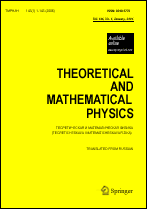|
This article is cited in 21 scientific papers (total in 21 papers)
A novel variational approach to pulsating solitons in the cubic-quintic Ginzburg–Landau equation
S. C. Mancas, S. R. Choudhury
Department of Matematics, University of Central Florida
Abstract:
Comprehensive numerical simulations of pulse solutions of the cubic-quintic
Ginzburg–Landau equation (CGLE) reveal various intriguing and
entirely novel classes of solutions. In particular, there are five new
classes of pulse or solitary wave solutions, i.e., pulsating, creeping,
snake, erupting, and chaotic solitons that are not stationary in time. They
are spatially confined pulse-type structures whose envelopes exhibit
complicated temporal dynamics. The numerical simulations also reveal very
interesting bifurcation sequences of these pulses as the CGLE parameters are
varied. We address the issues of central interest in this area, i.e.,
the conditions for the occurrence of the five categories of dissipative solitons
and also the dependence of both their shape and their stability on
the various CGLE parameters, i.e., the nonlinearity, dispersion, linear and
nonlinear gain, loss, and spectral filtering. Our predictions for
the variation of the soliton amplitudes, widths, and periods with the CGLE
parameters agree with the simulation results. We here present detailed
results for the pulsating solitary waves. Their regimes of occurrence,
bifurcations, and the parameter dependences of the amplitudes, widths, and
periods agree with the simulation results. We will address snakes and chaotic
solitons in subsequent papers. This overall approach fails to address only
the dissipative solitons in one class, i.e., the exploding or erupting
solitons.
Keywords:
variational formalism, complex Ginzburg–Landau equation, pulsating soliton.
Citation:
S. C. Mancas, S. R. Choudhury, “A novel variational approach to pulsating solitons in the cubic-quintic Ginzburg–Landau equation”, TMF, 152:2 (2007), 339–355; Theoret. and Math. Phys., 152:2 (2007), 1160–1172
Linking options:
https://www.mathnet.ru/eng/tmf6091https://doi.org/10.4213/tmf6091 https://www.mathnet.ru/eng/tmf/v152/i2/p339
|


|




 Contact us:
Contact us: Terms of Use
Terms of Use
 Registration to the website
Registration to the website Logotypes
Logotypes








 Citation in format
Citation in format 
